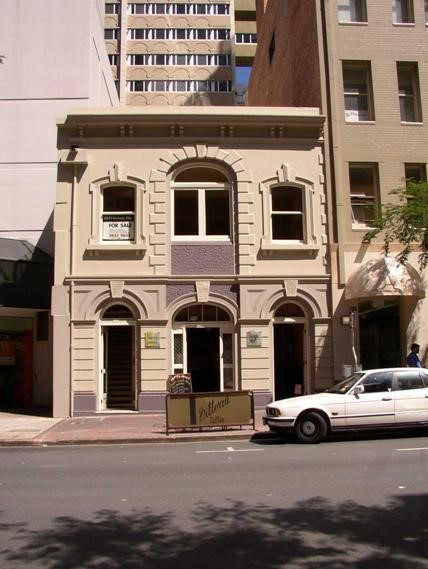Addresses
Type of place
Office building, Workshop
Period
Victorian 1860-1890
Style
Italianate
Addresses
Type of place
Office building, Workshop
Period
Victorian 1860-1890
Style
Italianate
Possibly built in 1863 to a design by James Cowlishaw, this two-storey, inner-city building survives as a remnant example of the commercial character of Brisbane’s Central Business District in the nineteenth century. Constructed for lawyer and agent general Sir James Francis Garrick, the building was leased to Henry Box and Son, coachbuilders, around 1863. The building continued to be associated with ironmongery, saddlery and general merchandise until the 1980s when it was used as a radio station. Together with a number of other substantially intact nineteenth century commercial buildings in Brisbane’s CBD, this building forms part of a remnant character precinct, reflecting the heritage of the local area.
Lot plan
L2_RP628
Key dates
Local Heritage Place Since —
Date of Citation —
Construction
Walls: MasonryPeople/associations
James Cowlishaw (Architect)Criterion for listing
(A) Historical; (B) Rarity; (E) AestheticInteractive mapping
Lot plan
L2_RP628
Key dates
Local Heritage Place Since —
Date of Citation —
Construction
Walls: MasonryPeople/associations
James Cowlishaw (Architect)Criterion for listing
(A) Historical; (B) Rarity; (E) AestheticInteractive mapping
History
This building predates the 1880s building boom and was possibly constructed around 1863, symbolising Brisbane’s early days as a free settlement. It was probably constructed between 1862-1872 and has been associated with ironmongery, saddlery and associated suppliers of general merchandise for over 100 years.
The site was owned by Sir James Francis Garrick, Lawyer and Agent General from 1872 until his death in 1907. The property remained in the Garrick family until 1911 when it was transferred to the Drummond Trust Ltd. The building was leased until 1924 when it became owner-occupied.
It is probable that the building predates 1872, possibly c.1862 when Henry Box & Son (advertised in the Queensland Post Office Directories as Saddlers’ & Coachmakers’ Ironmongers and General Merchants) were evident in Edward Street. The firm’s association with this segment of Edward Street lasted at least 30 years. In 1897 Brace Windle Blythe & Co (saddlers and ironmongers) occupied this building but moved to 98 Edward Street by 1901. During this period John Reid (iron and steel merchant, colliery furnisher) moved to 102-104 Edward Street. John Reid & Nephew continued to occupy these premises until c1912 when they moved to their new premises at 28-36 Charlotte Street
What is consistent throughout the latter half of the Victorian era and the first half of the twentieth century is that the building and adjoining 98 Edward Street were occupied by businesses carrying out similar trades. Brace Windle Blyth & Co were still trading at 102-104 Edward Street in 1944.
In the 1980s the building was used by Brisbane’s main rock radio station FM104 (previously 4MMM) and as the FM104 Travel Shop. In January 1989 the Travel Shop moved to the new Myer Centre in Elizabeth Street, but the first floor was still occupied by FM104.
The Hungry Heart Café and Takeway occupy 102-104 Edward Street on the ground floor and the Ginger Group hairdressing salon on the first floor.
Description
This two-storey building has a Victorian Italianate facade with three openings facing Edward Street. At ground floor level the central arch is elliptical and larger than the round headed arches on its either side. The lower section of the facade between the arched openings is moulded to resemble large-scale masonry blocks. The arches are emphasised by wide-label moulds and imposts, which join, forming a connecting line of moulding across the lower section of the facade. The arches are crowned by prominent keystones decorated with a vermiculated pattern.
The keystones rise to support a string course, which indicates the line of the upper floor. The upper section of the facade is dominated by an arched opening with a bold Gibbs surround. Recessed into this opening is a pair of casement windows and below the windows in a panel of rough-cast stucco. On either side of the arch are two windows. The window openings are slightly curved with a wide moulded window surround, large keystones and projecting window sills. Recessed into these openings are sash windows. At either end of the upper section of the facade, where it abuts adjoining buildings, the stucco is moulded to resemble quoins.
A cornice supported by decorative brackets runs across the top of the facade and forms the parapet.
An earlier photograph indicates that the doorway to number 104 was through the left arch and the other two arched openings contained windows. The central and left hand arch now contain modern glass doors and the right hand arch has a glass window, which continues, down to pavement level.
This building and the adjacent building at 106 Edward Street, together with the block of traditional warehouse buildings on the other side of the street, forms a remnant precinct of nineteenth century character buildings in Brisbane’s Central Business District. They make a significant contribution to a streetscape which otherwise lacks any significant identity.
Statement of significance
Relevant assessment criteria
This is a place of local heritage significance and meets one or more of the local heritage criteria under the Heritage planning scheme policy of the Brisbane City Plan 2014. It is significant because:
References
-
Land Title Records
-
Post Office Directories.
-
Aldine History of Queensland, Vol 11
-
Heritage Unit files, Brisbane City Council
Citation prepared by — Brisbane City Council (page revised September 2020)

